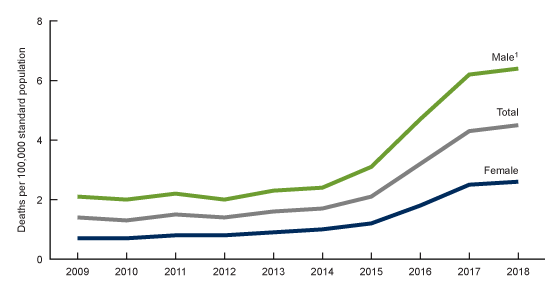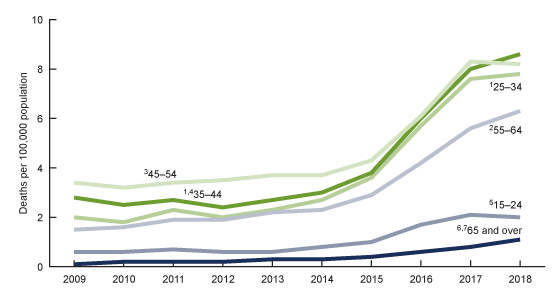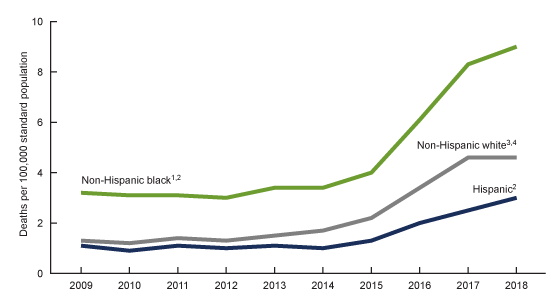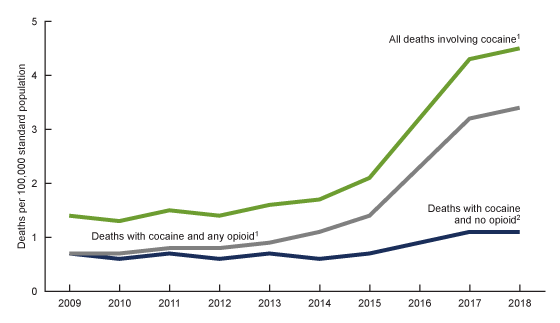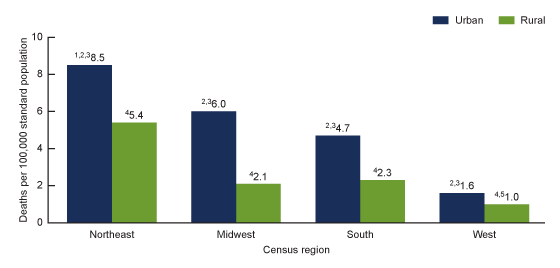Increase in Drug Overdose Deaths Involving Cocaine: United States, 2009–2018
- Key findings
- The age-adjusted rate of drug overdose deaths involving cocaine was stable between 2009 and 2013, then nearly tripled from 2013 through 2018.
- In 2018, the rate of drug overdose deaths involving cocaine was highest for adults aged 35–44.
- From 2009 through 2018, rates of drug overdose deaths involving cocaine were highest in the non-Hispanic black population.
- From 2014 through 2018, the rate of drug overdose deaths involving cocaine with concurrent involvement of opioids increased at a faster pace than drug overdose deaths involving cocaine without opioid involvement.
- In 2018, the rate of drug overdose deaths involving cocaine was highest in urban counties in the Northeast census region.
- Summary
- Definitions
- Data source and methods
- About the authors
- References
- Suggested citation
PDF Version (513 KB)
Key findings
Data from the National Vital Statistics System, Mortality
- The rate of drug overdose deaths involving cocaine was stable between 2009 and 2013, then nearly tripled from 1.6 per 100,000 in 2013 to 4.5 in 2018.
- In 2018, rates were highest for adults aged 35–44 and lowest for those aged 65 and over.
- In 2018, the rate for the non-Hispanic black population (9.0) was nearly twice that for the non-Hispanic white (4.6) and three times that for the Hispanic (3.0) populations.
- From 2014 through 2018, the rate of drug overdose deaths involving cocaine with opioids increased at a faster pace than the rate of cocaine deaths without opioids.
- In 2018, the rate of drug overdose deaths involving cocaine was highest in urban counties in the Northeast and lowest in rural counties in the West.
Deaths from drug overdose continue to contribute to mortality in the United States. The rate of drug overdose deaths involving cocaine has increased in recent years (1–3). This Data Brief provides additional information on drug overdose deaths involving cocaine by examining trends in rates by sex, age group, race and Hispanic origin, and by concurrent involvement of opioids from 2009 through 2018. Rates by urbanicity and census region in 2018 are also examined.
Keywords: : opioids, urban-rural, census region, National Vital Statistics System Mortality File
The age-adjusted rate of drug overdose deaths involving cocaine was stable between 2009 and 2013, then nearly tripled from 2013 through 2018.
- In 2018, there were 14,666 drug overdose deaths involving cocaine in the United States for an age-adjusted rate of 4.5 per 100,000 standard population (Figure 1).
- The age-adjusted rate of drug overdose deaths involving cocaine remained stable from 2009 through 2013 ranging from 1.3 to 1.6 per 100,000, then increased on average by 27% per year from 2013 through 2018.
- For males, the rate increased from 2.1 in 2009 to 6.4 in 2018. For females, the rate increased from 0.7 in 2009 to 2.6 in 2018. For each year, rates were 2.4 to 3.0 times higher for males than females.
Figure 1. Age-adjusted rates of drug overdose deaths involving cocaine, by sex: United States, 2009–2018
1Rates for males were significantly higher than for females for all years, p < 0.05.
NOTES: For total, males, and females, there was a stable trend from 2009 through 2013, then a significant increasing trend from 2013 through 2018, p < 0.05. Drug overdose deaths involving cocaine are identified using the International Classification of Diseases, 10th Revision (ICD–10) underlying cause-of-death codes X40–X44, X60–X64, X85, or Y10–Y14, with a multiple cause-of-death code T40.5. Age-adjusted death rates were calculated using the direct method and the 2000 U.S. standard population. Deaths may involve other drugs in addition to cocaine. In 2018, there were 14,666 drug overdose deaths involving cocaine. Access data table for Figure 1.
SOURCE: National Center for Health Statistics, National Vital Statistics System Mortality File.
In 2018, the rate of drug overdose deaths involving cocaine was highest for adults aged 35–44.
- In 2018, the rate of drug overdose deaths involving cocaine was highest for adults aged 35–44 (8.6 per 100,000) and lowest for those aged 65 and over (1.1) (Figure 2).
- Rates increased between 2009 and 2018 for all age groups, although the patterns of increase varied by age group with different rates of change over time.
- The largest percentage increases in rates occurred from 2013 to 2018 for age groups 25–34, 35–44 and 55–64. From 2013 through 2018, the rates for these age groups increased on average by 30% per year.
Figure 2. Rates of drug overdose deaths involving cocaine, by age group: United States, 2009–2018
1Stable trend from 2009 through 2013, then significant increasing trend from 2013 through 2018, p < 0.05.
2Significant increasing trend from 2009 through 2014 and from 2014 through 2018, with different rates of change over time, p < 0.05.
3Stable trend from 2009 through 2014, then significant increasing trend from 2014 through 2018, p < 0.05.
4Age group with statistically highest rate in 2018, p < 0.05.
5Significant increasing trend from 2009 through 2018, p < 0.05.
6Significant increasing trend from 2009 through 2015 and from 2015 through 2018, with different rates of change over time, p < 0.05.
7Age group with statistically lowest rate in 2018, p < 0.05.
NOTES: Drug overdose deaths involving cocaine are identified using the International Classification of Diseases, 10th Revision (ICD–10) underlying cause-of-death codes X40–X44, X60–X64, X85, or Y10–Y14, with a multiple cause-of-death code T40.5. Deaths may involve other drugs in addition to cocaine. Access data table for Figure 2.
SOURCE: National Center for Health Statistics, National Vital Statistics System Mortality File.
From 2009 through 2018, rates of drug overdose deaths involving cocaine were highest in the non-Hispanic black population.
- Throughout the study period, the rates of drug overdose deaths involving cocaine were highest for the non-Hispanic black population, followed by non-Hispanic white and the Hispanic population (Figure 3).
- In 2018, the rate of drug overdose deaths involving cocaine in the non-Hispanic black population (9.0 per 100,000) was nearly twice that of the non-Hispanic white population (4.6) and three times that of the Hispanic population (3.0).
- In general, for each group, the rate remained stable from 2009 through 2013–2014, then increased in subsequent years. The rate for the non-Hispanic white population was the same in 2017 and 2018 (4.6).
Figure 3. Age-adjusted rates of drug overdose deaths involving cocaine, by race and Hispanic origin: United States, 2009–2018
1Rates for the non-Hispanic black population were significantly higher than for the non-Hispanic white and Hispanic populations for all years, p < 0.05.
2Stable trend from 2009 through 2014, then significant increasing trend from 2014 through 2018, p < 0.05.
3Rates for the non-Hispanic white population were significantly higher than for the Hispanic population for all years, p < 0.05.
4Stable trend from 2009 through 2013, then significant increasing trend from 2013 through 2018, p < 0.05.
NOTES: Drug overdose deaths involving cocaine are identified using the International Classification of Diseases, 10th Revision (ICD–10) underlying cause-of-death codes X40–X44, X60–X64, X85, or Y10–Y14, with a multiple cause-of-death code T40.5. Age-adjusted death rates were calculated using the direct method and the 2000 U.S. standard population. Deaths may involve other drugs in addition to cocaine. Access data table for Figure 3.
SOURCE: National Center for Health Statistics, National Vital Statistics System Mortality File.
From 2014 through 2018, the rate of drug overdose deaths involving cocaine with concurrent involvement of opioids increased at a faster pace than drug overdose deaths involving cocaine without opioid involvement.
- For drug overdose deaths involving cocaine with concurrent involvement of opioids, the rate remained stable from 2009 through 2013 ranging from 0.7 to 0.9 per 100,000, then increased to 3.4 in 2018 (Figure 4).
- For drug overdose deaths involving cocaine but without involvement of opioids, the rate remained stable from 2009 through 2014 ranging from 0.6 to 0.7 per 100,000, then increased to 1.1 in 2018.
Figure 4. Age-adjusted rates of drug overdose deaths involving cocaine, by concurrent involvement of opioids: United States, 2009–2018
1Stable trend from 2009 through 2013, then significant increasing trend from 2013 through 2018, p < 0.05.
2Stable trend from 2009 through 2014, then significant increasing trend from 2014 through 2018, p < 0.05.
NOTES: Drug overdose deaths involving cocaine are identified using the International Classification of Diseases, 10th Revision (ICD–10) underlying cause-of-death codes X40–X44, X60–X64, X85, or Y10–Y14, with a multiple cause-of-death code T40.5. Deaths with concurrent involvement of opioids also have a multiple cause-of-death code of T40.0–T40.4 or T40.6. Age-adjusted death rates were calculated using the direct method and the 2000 U.S. standard population. Deaths may involve other drugs in addition to cocaine and opioids. Access data table for Figure 4.
SOURCE: National Center for Health Statistics, National Vital Statistics System Mortality File.
In 2018, the rate of drug overdose deaths involving cocaine was highest in urban counties in the Northeast census region.
- In 2018, the age-adjusted rates of drug overdose deaths involving cocaine were higher in urban than in rural counties for all census regions (Figure 5).
- Among urban counties, the rates were highest in the Northeast (8.5), followed by the Midwest (6.0), South (4.7), and West (1.6).
- Among rural counties, rates were highest in the Northeast (5.4), similar between the Midwest (2.1) and South (2.3), and lowest in the West (1.0).
Figure 5. Age-adjusted rates of drug overdose deaths involving cocaine, by urbanicity and census region: United States, 2018
1Rate is significantly highest among all groups (p < 0.05.).
2Rate for urban group is significantly higher than for rural group in this census region (p < 0.05.).
3Among urban counties, the rate in the Northeast is significantly higher than the rates in the Midwest, South, and West; the rate in the Midwest is significantly higher than the rates in the South and West; and the rate in the South is significantly higher than the rate in the West (p < 0.05.).
4Among rural counties, the rate in the Northeast is significantly higher than the rates in the Midwest, South and West; the rate in the Midwest is statistically similar to the rate in the South and is significantly higher than the rate in the West; and the rate in the South is significantly higher than the rate in the West (p < 0.05.).
5Rate is significantly lowest among all groups (p < 0.05.).
NOTES: Drug overdose deaths involving cocaine are identified using the International Classification of Diseases, 10th Revision (ICD–10) underlying cause-of-death codes X40–X44, X60–X64, X85, or Y10–Y14, with a multiple cause-of-death code T40.5. Age-adjusted death rates were calculated using the direct method and the 2000 U.S. standard population. Deaths may involve other drugs in addition to cocaine. The decedent’s county of residence was classified as urban or rural based on the 2013 NCHS Urban-Rural Classification Scheme for Counties. Access data table for Figure 5.
SOURCE: National Center for Health Statistics, National Vital Statistics System, Mortality File.
Summary
This report updates statistics on deaths from drug overdoses involving cocaine in the United States, including information on trends from 2009 through 2018. After remaining stable from 2009 through 2013, rates of drug overdose deaths involving cocaine increased on average by about 27% per year from 2013 through 2018. The rate of drug overdose deaths involving cocaine in 2018 was more than triple the rate in 2009 (4.5 and 1.4 per 100,000, respectively). Throughout the study period, the rates for males were higher than the rates for females. In 2009, rates were highest among adults aged 45–54, while in 2018, adults aged 35–44 had the highest rates. Rates increased between 2009 and 2018 for all age groups, although the patterns of increase varied by age group. In 2018, the rate for the non-Hispanic black population (9.0) was nearly twice that of the non-Hispanic white population (4.6) and three times that of the Hispanic population (3.0). Differences in rates also occurred across regions of the United States and by urbanicity of county of residence. In 2018, the rate in urban counties in the Northeast was 8.5 times that of rural counties in the West (8.5 and 1.0, respectively). Finally, a key factor in the recent rise in deaths due to cocaine is the concurrent involvement of opioids. From 2013 to 2018, the rate of drug overdose deaths involving cocaine with concurrent opioid involvement increased at a faster pace than the rate for deaths without concurrent opioid involvement.
Definitions
Drug poisoning (overdose) deaths: Includes deaths resulting from unintentional or intentional overdose of a drug, being given the wrong drug, taking a drug in error, or taking a drug inadvertently.
Any opioids: Includes natural and semisynthetic opioids (such as opium, morphine, codeine, hydrocodone, and oxycodone), synthetic opioids (such as methadone, fentanyl, fentanyl analogs, and tramadol), and mentions of opiates or opioids without naming a specific drug.
Data source and methods
Estimates are based on the National Vital Statistics System multiple-cause-of-death mortality files (4). Drug poisoning (overdose) deaths involving cocaine were defined as deaths having an International Classification of Diseases, 10th Revision (ICD–10) underlying-cause-of-death code of X40–X44 (unintentional drug poisoning), X60–X64 (suicide by drug poisoning), X85 (homicide by drug poisoning), or Y10–Y14 (drug poisoning of undetermined intent) with a multiple cause-of-death code of T40.5. Deaths with concurrent involvement of opioids had a multiple cause-of-death code of T40.0–T40.4 or T40.6, in addition to T40.5.
The decedent’s state of residence was grouped into one of four Census regions: Northeast, Midwest, South, and West (5). Urbanization level of the decedent’s county of residence was initially categorized using the 2013 NCHS Urban–Rural Classification Scheme for Counties (6). In this scheme, counties are classified into six urbanization levels based primarily on metropolitan–nonmetropolitan status and population distribution. Metropolitan (urban) counties include large central counties, the fringes of large counties (suburbs), medium counties, and small counties. Nonmetropolitan (rural) counties include micropolitan statistical areas and noncore areas, including open countryside, rural towns (populations of less than 2,500), and areas with populations of 2,500–49,999 that are not part of larger labor market areas. For this report, the four metropolitan categories (i.e., large central metro, large fringe metro, medium metro, and small metro) were grouped as urban counties. The two nonmetropolitan categories (i.e., micropolitan and noncore) were grouped as rural counties.
Age-adjusted death rates were calculated using the direct method and adjusted to the 2000 U.S. standard population (7). Trends in age-adjusted death rates were evaluated using the Joinpoint Regression Program (Version 4.8.0.1) (8). Joinpoint software fitted weighted least-squares regression models to the rates on the log transform scale. Analyses were set to allow a maximum of three joinpoints across the period, a minimum of three observed time points from any given joinpoint to either end of the data, and a minimum of four observed time points between any two joinpoints. The permutation tests for model (number of joinpoints) significance were set at an overall alpha level of 0.05 (9). Pairwise comparisons of rates were conducted using the z test with an alpha level of 0.05 (7).
Several factors related to death investigation and reporting may affect measurement of death rates involving specific drugs. At autopsy, the substances tested for and the circumstances under which the toxicology tests are performed vary by jurisdiction. This variability is more likely to affect drug-specific death rates than the overall drug overdose death rate. The percentage of drug overdose deaths that identified the specific drugs involved varied by year, ranging from 75%–79% from 2009 through 2013 and from 81%–92% from 2014 through 2018. Additionally, drug overdose deaths may involve multiple drugs; therefore, some deaths may involve other drugs in addition to cocaine and opioids.
About the authors
Holly Hedegaard, Merianne Rose Spencer, and Matthew Garnett are with the National Center for Health Statistics, Division of Analysis and Epidemiology.
References
- Hedegaard H, Miniño AM, Warner M. Drug overdose deaths in the United States, 1999–2018. NCHS Data Brief, no 356. Hyattsville, MD: National Center for Health Statistics. 2020.
- Ahmad FB, Rossen LM, Sutton P. Provisional drug overdose death counts. National Center for Health Statistics. 2020.
- Kariisa M, Scholl L, Wilson N, Seth P, Hoots B. Drug overdose deaths involving cocaine and psychostimulants with abuse potential—United States, 2003–2017. MMWR Morb Mortal Wkly Rep 68(17):388–95. 2019.
- National Center for Health Statistics. Public-use data files: Mortality multiple cause files. 2018.
- United States Census. Regional Offices. 2020.
- Ingram DD, Franco SJ. 2013 NCHS Urban–rural classification scheme for counties. National Center for Health Statistics. Vital Health Stat 2(166). 2014.
- Murphy SL, Xu JQ, Kochanek KD. Deaths: Final data for 2010. National Vital Statistics Reports; vol 61 no 4. Hyattsville, MD: National Center for Health Statistics. 2013.
- National Cancer Institute. Joinpoint Regression Program (Version 4.8.0.1) [computer software]. 2019.
- Ingram DD, Malec DJ, Makuc DM, Kruszon-Moran D, Gindi RM, Albert M, et al. National Center for Health Statistics guidelines for analysis of trends. National Center for Health Statistics. Vital Health Stat 2(179). 2018.
Suggested citation
Hedegaard H, Spencer MR, Garnett MF. Increase in drug overdose deaths involving cocaine: United States, 2009–2018. NCHS Data Brief, no 384. Hyattsville, MD: National Center for Health Statistics. 2020.
Copyright information
All material appearing in this report is in the public domain and may be reproduced or copied without permission; citation as to source, however, is appreciated.
National Center for Health Statistics
Brian C. Moyer, Ph.D., Director
Amy M. Branum, Ph.D., Acting Associate Director for Science
Division of Analysis and Epidemiology
Irma E. Arispe, Ph.D., Director
Kevin C. Heslin, Ph.D., Associate Director for Science
